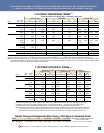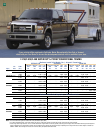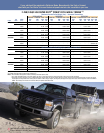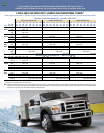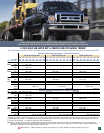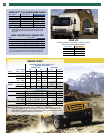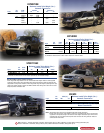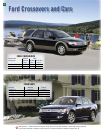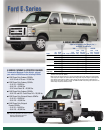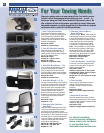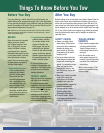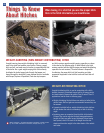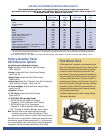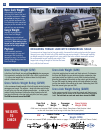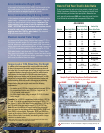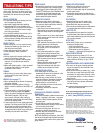
Trailer towing places extra demands on your
driving skills. Here are a few basic tips to help
you transport your trailer and its contents safely,
comfortably and without abusing the towing
vehicle:
WEIGHT DISTRIBUTION
• For optimum handling and braking, the load
must be properly distributed.
• Keep center of gravity low for best handling.
• Approximately 60% of the allowable cargo
weight should be in the front half of the trailer
and 40% in the rear (within limits of tongue
load or king pin weight).
• Load should be balanced from side to side to
optimize handling and tire wear.
• Load must be firmly secured to prevent shifting
during cornering or braking, which could result
in a sudden loss of control.
BEFORE STARTING
• Before setting out on a trip, practice turning,
stopping and backing up your trailer in an
area away from heavy traffic.
• Know clearance required for trailer roof.
• Check equipment (make a checklist).
BACKING
• Back up slowly, with someone spotting near
the rear of the trailer to guide you.
• Place one hand at bottom of steering wheel
and move it in the direction you want the
trailer to go.
• Make small steering inputs – slight movement
of steering wheel results in much greater
movement in rear of trailer.
TURNING
• When turning, be sure to swing wide enough
to allow trailer to avoid curbs and other
obstructions.
BRAKING (Also see page 27)
• Allow considerably more distance for stopping
with trailer attached.
• Remember, the braking system of the tow
vehicle is rated for operation at the GVWR, not
GCWR.
• If your tow vehicle is a Super Duty Pickup or
Chassis Cab and your trailer has electric
brakes, the optional TowCommand Integrated
Trailer Brake Controller (TBC) will help
assure smooth, effective trailer braking by
automatically proportioning the trailer braking
to that of the towing vehicle.
• If your trailer starts to sway, apply brake pedal
gradually. The sliding lever on the TBC should
be used only for manual activation of trailer
brakes when adjusting the gain. Misuse, such
as application during trailer sway, could cause
instability of trailer and/or tow vehicle.
TOWING ON HILLS
• Downshift the transmission to assist braking
on steep downgrades and to increase power
(reduce lugging) when climbing hills. With
TorqShift
®
transmission, select Tow/Haul mode
to automatically eliminate unwanted gear
search when going uphill and help control
vehicle speed when going downhill.
PARKING WITH A TRAILER
• Whenever possible, vehicles with trailers
should not be parked on a grade. However, if
it is necessary, place wheel chocks under the
trailer’s wheels as follows:
– Apply the foot service brakes and hold.
– Have another person place the wheel chocks
under the trailer wheels on the downgrade
side.
– Once the chocks are in place, release brake
pedal, making sure the chocks will hold the
vehicle and trailer.
– Apply the parking brake.
– Shift automatic transmission into Park, or
manual transmission into Reverse.
NOTE: With 4-wheel drive, make sure
the transfer case is not in Neutral (if
applicable).
• To start, after being parked on a grade:
– Apply the foot service brake and hold.
– Start the engine with transmission in Park
(automatic) or Neutral (manual).
– Shift the transmission into gear and release
the parking brake.
– Release the brake pedal and move the
vehicle uphill to free the chocks.
– Apply the brake pedal and hold while
another person retrieves the chocks.
ACCELERATION AND PASSING
• The added weight of the trailer can
dramatically decrease the acceleration of the
towing vehicle – exercise caution.
• When passing a slower vehicle, be sure to
allow extra distance. Remember, the added
length of the trailer must clear the other
vehicle before you can pull back in.
• Signal and make your pass on level terrain
with plenty of clearance.
• If necessary, downshift for improved
acceleration.
DRIVING WITH AN AUTOMATIC OVERDRIVE
TRANSMISSION
• With certain automatic overdrive transmissions,
towing – especially in hilly areas – may cause
excessive shifting between overdrive and the
next lower gear.
• To eliminate this condition and achieve
steadier performance, overdrive can be locked
out (see vehicle Owner Guide).
• If excessive shifting does not occur, use
overdrive to optimize fuel economy.
• Overdrive may also be locked out to obtain
engine braking on downgrades.
NOTE: With TorqShift
®
transmission, select Tow/
Haul mode to automatically eliminate unwanted
gear search and help control vehicle speed when
going downhill.
DRIVING WITH SPEED CONTROL
• When driving uphill with a heavy load,
significant speed drops may occur.
• An 8- to 14-mph speed drop will automatically
cancel speed control.
• Temporarily resume manual control through
the vehicle’s accelerator pedal until the terrain
levels off.
TIRE PRESSURE
• Underinflated tires get hot and may fail,
leading to possible loss of vehicle control.
• Overinflated tires may wear unevenly.
• Tires should be checked often for conformance
to recommended cold inflation pressures.
SPARE TIRE USE
• A conventional full-size spare tire is required
for trailer towing (mini spare tires should not be
used; always replace the spare tire with the road
tire as soon as possible).
ON THE ROAD
• After about 50 miles, stop in a protected
location and double-check:
– Trailer hitch attachment.
– Lights and electrical connections.
– Trailer wheel lug nuts for tightness.
– Engine oil – check regularly throughout trip.
HIGH ALTITUDE OPERATION
• Gasoline engines lose power by 3-4% per
1,000 ft. elevation. To maintain performance,
reduce GVWs and GCWs by 2% per 1,000 ft.
elevation.
POWERTRAIN/FRONTAL AREA CONSIDERATIONS
• The charts in this guide show the minimum
engine size needed to move the GCW of tow
vehicle and trailer.
• Under certain conditions, however, (e.g., when
the trailer has a large frontal area that adds
substantial air drag or when trailering in hilly
or mountainous terrain) it is wise to choose a
larger engine.
• Selecting a trailer with a low-drag, rounded
front design will help optimize performance
and fuel economy.
NOTE: For additional trailering information pertaining to your Ford
vehicle, refer to the vehicle Owner Guide.
For the Latest RV/Towing Information, Check Out the Ford
Fleet Web Site at www.fleet.ford.com/showroom/
rv_trailer_towing/2008/2008_default.asp
Photography, illustrations and information presented
herein were correct when approved for printing. Ford
Motor Company reserves the right to discontinue
or change at any time the specifications or designs
without incurring obligation. Some features shown or
described are optional at extra cost. Some options
are required in combination with other options.
Consult your Ford Dealer for the latest, most complete
information on models, features, prices and availability.
Many of the recreational vehicles shown in this
brochure are modified or manufactured by companies
other than Ford Motor Company. Ford assumes no
responsibility for such modifications or manufacturing.
RV-VER8173-1007
Metric Conversion – To obtain information in
centimeters, multiply feet by 30.48; to obtain
information in kilometers, multiply miles by 1.6.
Retailer Education and Training
TRAILERING TIPS



